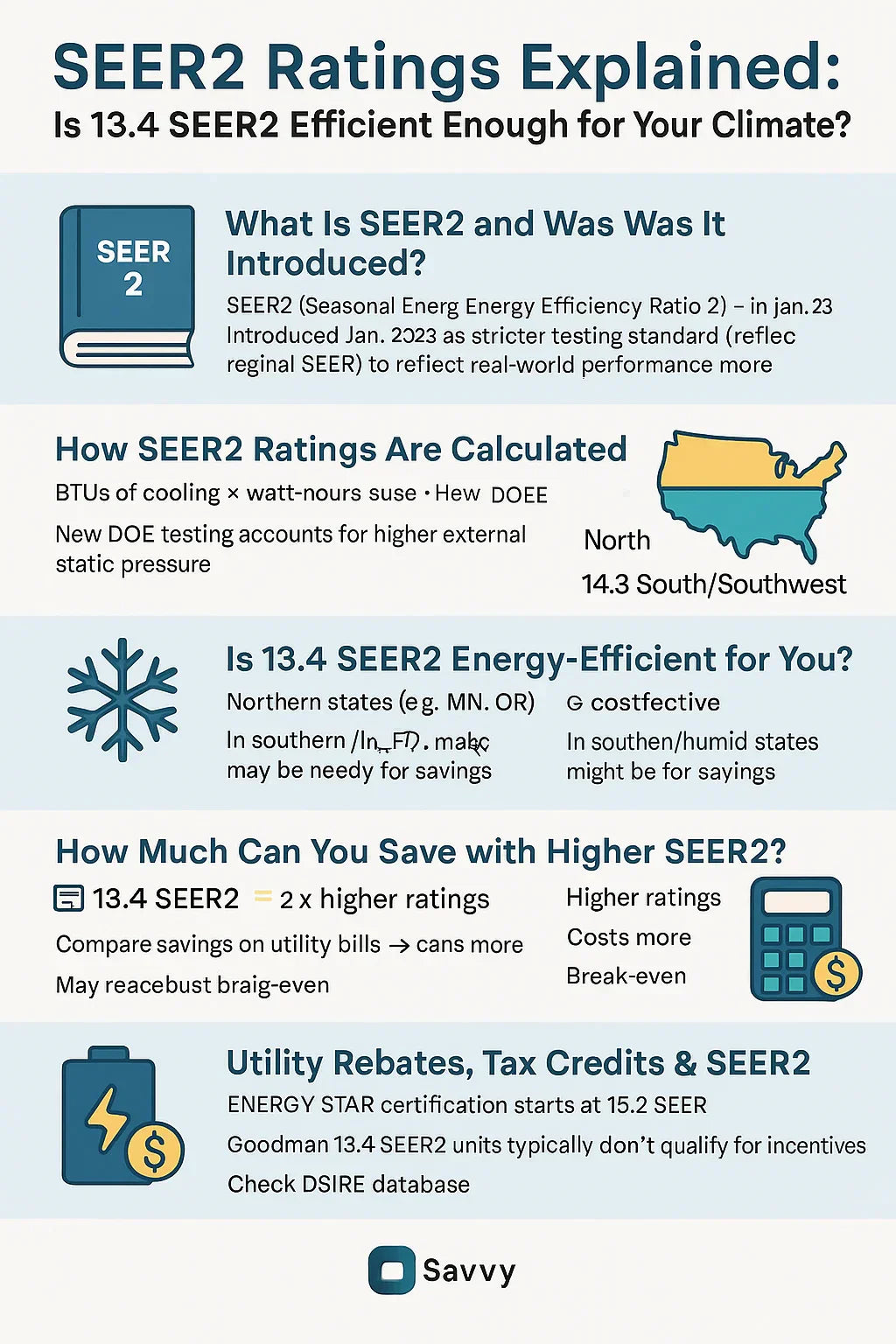If you're shopping for a new HVAC system like the Goodman 2.5 Ton 13.4 SEER2 Self-Contained Package Unit, you’ve likely come across the term SEER2. But what does it really mean, and how can you tell if a 13.4 SEER2 rating is efficient for your region?
This guide breaks down the new SEER2 standard, regional efficiency requirements, and whether 13.4 SEER2 is good enough for where you live.
📖 What Is SEER2 and Why Was It Introduced?
Old vs New:
-
SEER (Seasonal Energy Efficiency Ratio): Measures cooling output divided by energy input over a season.
-
SEER2: A 2023 update by the Department of Energy (DOE) that uses higher static pressure to simulate real-world conditions.
Why the Change?
The original SEER ratings were often based on ideal lab conditions. SEER2 introduces more realistic blower conditions, offering a more accurate efficiency comparison.
🔗 Verified Source: Energy.gov on Air Conditioner Efficiency
⚙️ How SEER2 Ratings Are Calculated
SEER2 = BTUs of cooling ÷ Watt-hours of electricity (under higher airflow resistance)
-
For the same equipment, SEER2 ratings are generally 4–5% lower than previous SEER ratings.
-
Example: An old SEER 14 system may now score about 13.4 SEER2.
🔗 Tech Guide: AHRI.org on Testing Standards
🌎 SEER2 Regional Minimums: What’s Required Where?
As of 2023, SEER2 regional standards depend on whether you live in:
| Region | Packaged Unit Minimum | Split Unit Minimum |
|---|---|---|
| North | 13.4 SEER2 | 14.3 SEER2 |
| South | 14.3 SEER2 | 15.2 SEER2 |
| Southwest | 14.3 SEER2 | 15.2 SEER2 + EER2 floor |
🔗 View Full Map: Trane Guide to SEER2
The Goodman 2.5 Ton 13.4 SEER2 unit is compliant in northern states, but does not meet southern/southwestern efficiency minimums.
🧊 Is 13.4 SEER2 Energy-Efficient for Your Climate?
🌧️ Best Fit:
-
Moderate climates (Pacific NW, Midwest, Mid-Atlantic)
-
Short cooling seasons
-
Budget-conscious homeowners
🔥 Consider Upsizing SEER2:
-
High cooling demand (Southeast, Texas, Arizona)
-
Poor home insulation
-
Long-term savings > upfront savings
⚡ Check your cooling hours by ZIP: NOAA Degree Days Tool
📊 How Much Can You Save with Higher SEER2?
Let’s compare annual energy use:
| SEER2 Rating | Estimated Cooling Cost/year* |
| 13.4 | ~$470 |
| 15.2 | ~$405 |
| 17.0 | ~$360 |
*Based on 2.5 ton unit, 1,500 sq. ft. home, 1,500 cooling hours, $0.13/kWh average
Over 10 years:
-
13.4 SEER2: $4,700
-
15.2 SEER2: $4,050
-
Savings: ~$650
If upgrading to 15.2 SEER2 costs $500 more upfront, you’d break even in ~8 years.
🔗 Calculator: ENERGY STAR AC Savings Tool
🏡 13.4 SEER2 in the Real World
When it works well:
-
Homes < 1,800 sq. ft.
-
Northern or temperate states
-
Moderate AC usage
When it might underperform:
-
Large, multi-zone homes
-
Hot/humid climates
-
Older, leaky ductwork
✉ Need help assessing your home? Ask your HVAC tech to run a Manual J load calc.
💸 Utility Rebates, Tax Credits & SEER2
13.4 SEER2 does not meet ENERGY STAR requirements.
| Incentive | SEER2 Min | Eligible? |
| ENERGY STAR | 15.2 | ❌ No |
| Federal Tax Credit | 15.2+ | ❌ No |
| Local Utility Rebate | Varies | ⚠ Depends |
🔗 Check local incentives at DSIREUSA.org
💡 Savvy Buyer Questions
-
Will I stay in my home long enough to recoup the savings of a higher SEER2 unit?
-
What’s my state’s power cost per kWh?
-
Do I qualify for incentives to offset a higher SEER2 system?
-
Is my existing ductwork compatible with a higher-SEER2 model?
📄 Final Verdict: Is 13.4 SEER2 Enough for You?
✅ Choose 13.4 SEER2 if:
-
You live in the North or Midwest
-
Your home is 1,200–1,800 sq. ft.
-
Your usage is moderate and seasonal
-
You’re budget-conscious
⚠ Consider 14.3–15.2+ SEER2 if:
-
You live in the South or Southwest
-
Your AC runs 6+ months a year
-
You want ENERGY STAR perks or long-term efficiency
Looking for more insights? Explore our full HVAC cluster, including:
"Is a 2.5 Ton AC the Right Size for Your Home?"
"How to Compare SEER vs SEER2 Ratings"
"Understanding Packaged HVAC Efficiency Ratings"
Stay Savvy. Buy smart.
In the next topic we will read about: Goodman Package Units vs. Split Systems: What’s Better for Your Setup?







